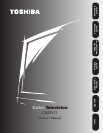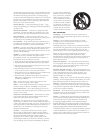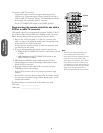
SERVICE / RÉPARATION
Damage Requiring Service — Unplug the TV set from the wall outlet and
refer servicing to qualified service personnel under the following conditions:
Dommages exigeant une réparation — Débranchez le téléviseur de la
prise murale et faites appel à un réparateur qualifié dans les cas suivants:
a. When the power cord or plug is damaged or frayed.
a. Le cordon d’alimentation ou la prise est endommagée ou usée.
b. When liquid has been spilled into the TV set.
b. Du liquide a été répandu sur le téléviseur.
c. When the TV set has been exposed to rain or water.
c. Le téléviseur a été exposé à la pluie ou à l’eau.
d. When the TV set has been subject to excessive shock by being
dropped, or the cabinet has been damaged.
d. Le téléviseur est tombé et a subi un choc violent, ou le coffret a été
endommagé.
e. When the TV set does not operate normally even though you follow
the operating instructions. Adjust only those controls that are specified
in the operating instructions. Improper adjustment of other controls
may result in damage and will often require extensive work by a
qualified technician to restore the TV set to normal operation.
When the TV set exhibits a distinct change in performance. This
indicates a need for service.
e. Le téléviseur ne fonctionne pas normalement bien que vous respectiez
les instructions du mode d’emploi. Faites uniquement les réglages
indiqués dans le mode d’emploi, car tout autre réglage risque de
provoquer des dommages qui nécessiteront des réparations
supplémentaires pour que le téléviseur fonctionne de nouveau
normalement.
Quand le téléviseur n’offre plus les mêmes performances, une révision
est aussi nécessaire.
Servicing — Do not attempt to service the TV set yourself. To open or
remove the covers may expose you to dangerous voltage or other
hazards. Refer all servicing to qualified service personnel.
Réparation — N’essayez pas de réparer vous-même le téléviseur. L’ouverture et
le retrait des panneaux peut exposer à une tension dangereuse ou à d’autres
dangers. Faites toujours appel à un réparateur compétent.
Replacement Parts — When replacement parts are required, be sure
the service technician certifies in writing that he has used replacement
parts specified by the manufacturer that have the same characteristics as
the original parts. Unauthorized substitutions may result in fire, electric
shock, or other hazards.
Pièces de rechange — Lorsque des pièces doivent être remplacées,
demandez au réparateur qu’il vous garantisse par écrit qu’il a utilisé les
pièces spécifiées par la fabricant et ayant les mêmes caractéristiques que
les pièces d’origine. Des substitutions non autorisées peuvent être cause
d’incendie, électrocution ou tout autre accident.
Safety Check — Upon completion of any service or repairs to the TV
set, ask the service technician to perform routine safety checks (as
specified by the manufacturer) to determine that the TV set is in safe
operating condition, and to so certify.
Contrôle de sécurité — Après tout entretien ou toute réparation,
demandez au réparateur d’effectuer des contrôles de sécurité (comme
prescrit par le fabricant), pour voir si le téléviseur fonctionne
normalement, et de vous le certifier.
When the TV set reaches the end of its useful life, improper disposal
could result in a picture tube implosion. Ask a qualified service
technician to dispose of the TV set.
Quand le téléviseur est devenu inutilisable, ne pas le déposer n’importe
où afin d’éviter une implosion du tube. Demandez à un réparateur
compétent où vous devez le déposer.
ANTENNA / ANTENNE
Outdoor Antenna Grounding — If an outdoor antenna is installed,
follow the precautions below.
An outdoor antenna system should not be located in the vicinity of
overhead power lines or other electric light or power circuits, or where
it can come in contact with such power lines or circuits.
WHEN INSTALLING AN OUTDOOR ANTENNA SYSTEM,
EXTREME CARE SHOULD BE TAKEN TO KEEP FROM
CONTACTING SUCH POWER LINES OR CIRCUITS AS
CONTACT WITH THEM IS ALMOST INVARIABLY FATAL.
Be sure the antenna system is grounded so as to provide some
protection against voltage surges and built-up static charges. Section
810 of the National Electrical Code in the USA and Section 54 of the
Canadian Electrical Code in Canada provides information with respect
to proper grounding of the mast and supporting structure, grounding
of the lead-in wire to an antenna discharge unit, size of grounding
conductors, location of antenna discharge unit, connection to
grounding electrodes, and requirements for the grounding electrode.
Mise à la terre de l’antenne extérieure — Si vous installez une antenne
extérieure, veuillez respecter les précautions ci-dessous.
Une antenne extérieure ne doit pas être installée près de lignes électriques
aériennes ou autres circuits d’alimentation ou d’éclairage électriques, ou
dans un endroit où elle pourrait toucher de tels circuits ou lignes.
LORS DE L’INSTALLATION D’UNE ANTENNE EXTÉRIEURE,
SOYEZ EXTRÊMEMENT PRUDENT POUR ÉVITER DE
TOUCHER DE TELS CIRCUITS OU LIGNES ÉLECTRIQUES,
CAR UN TEL CONTACT ENTRAINE PRATIQUEMENT
TOUJOURS LA MORT.
L’antenne doit être reliée à la terre par mesure de sécurité contre les
hausses brusques de tension et l’électricité statique accumulée. La
section 810 du National Electrical Code aux Etats-Unis et la section 54
du Code électrique du Canada fournissent des informations sur le
raccordement à la terre correct du mât et de la structure porteuse, le
raccordement de la descente d’antenne à une unité de décharge
d’antenne, la taille des conducteurs de mise à la terre, l’emplacement de
l’unité de décharge d’antenne, la connexion aux électrodes de terre, et
les spécifications desélectrodes de terre.
iv


















